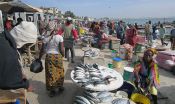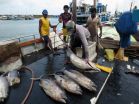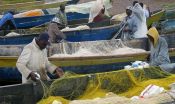(Press-News.org) The Alaska salmon fishery is touted as one of the best in the world. When measured with an ecological yardstick, it is - fish stocks are healthy and the fishery is certified by the Marine Stewardship Council as consistently meeting rigorous biological standards. Fish are individually counted as they swim upstream to ensure there are enough to breed.
But Alaska salmon falls short and lags behind some of the world's fisheries in how it benefits local fishermen, processing workers and nearby rural communities, according to a new assessment that ranks the vitality of a fishery by looking at its economic and community benefits as well as its ecological health.
The Fishery Performance Indicators are the most comprehensive, global tool that considers social factors in addition to the usual biological measures when gauging a fishery's health, said Chris Anderson, a University of Washington associate professor of aquatic and fishery sciences and a lead author of a paper published May 6 in the journal PLOS ONE describing the new methodology.
"This tool is designed to help us evaluate a fishery system's performance toward achieving economic, community and ecological sustainability - the 'triple bottom line,'" said co-author James Anderson, director of the Institute for Sustainable Food Systems at the University of Florida.
The authors found that globally, less healthy fish stocks usually lead to worse economic and community outcomes. However, they identified several cases where weaker stocks contribute importantly to the livelihoods of harvesters and their communities, and healthy fish stocks generated meager economic or community benefits.
"It is often assumed that economic and social benefits always follow healthy stocks, but this is rarely tested due to the lack of social data," Chris Anderson said. "Our strategy was to develop a rapid assessment instrument that would organize the knowledge of local fishery experts to help us understand how harvesters and processors are performing economically and how the fishery is supporting its community. Economically effective management, access to high-value markets and having other income opportunities often play a larger role in human outcomes than stock health, especially in communities where fishing is a large share of the economy."
Anderson and 26 co-authors at the World Bank and other universities and organizations around the world chose 61 fisheries as initial case studies to build the assessment tool.
Since 2010, they have visited and studied fisheries ranging from Alaska halibut and Oregon Dungeness crab to Norway cod, Louisiana shrimp, Nile perch in Uganda and blue swimming crabs in Indonesia to gather information and refine the tool.
Here's how it works: The authors created dozens of measurable statements that capture the range of three performance indicators - ecology, economics and community. Example statements relate to the degree of overfishing, price trends, the capacity of processors to export to the U.S. and E.U., health care access for processing workers, captains' earnings relative to other jobs in the region and the social standing of the crew.
Then, to characterize a fishery, the authors drew on the knowledge of local experts who work with fishermen, processors and community leaders, scoring each statement from one to five, with five being the best, based on carefully defined categories of performance. The responses in each category were then averaged.
The results are sometimes surprising. Alaska salmon ranks 4.88 (almost a perfect five) in its ecological performance, but it was a mere 2.86 in economics and 3.40 in community performance. Alternatively, Colombian artisanal shrimp only hit 2.25 for ecological performance but reached 4.20 for its community impact. (See the paper for a full list.)
In the case of Alaska salmon, nearly all of the money businesses make selling the fish is spent catching it. The fishery operates as a derby, deploying several times the boats needed to catch the fish, and it's expensive and financially risky to operate seasonal processors in rural Alaska.
Alternatively, in many developing countries a fishery whose stock is at a low level might still provide a key source of income within a community where resources are few.
"This highlights the importance of selecting development and management strategies that not only sustain stocks but also sustain industries and communities," Chris Anderson said.
The co-authors used several international workshops and pilot cases with different users to refine their final set of statements to make the instrument robust across many different fisheries. They plan to add data from more fisheries and associate differences in performance with fishery management and governance factors.
"An overarching purpose is to be able to compare fisheries systems across species, management approaches and nations. With our new metric, I would argue you can now compare fisheries systems in Ghana to those in Iceland," James Anderson said.
As former lead of the World Bank's global program for fisheries and aquaculture, he said these indicators could be very useful for institutions like the World Bank, the U.S. Agency for International Development, and nongovernmental organizations that fund projects on fisheries reform in developing countries to monitor and evaluate progress.
"Researchers will be able to make meaningful comparisons between large-scale and small-scale fisheries, nearshore and offshore fisheries, operations in industrialized countries compared to ones in developing countries, seafood aimed at export markets versus seafood primarily consumed locally, and a host of other possibilities," said co-author Martin Smith, a professor of environmental economics at Duke University.
INFORMATION:
Other primary co-authors are Jingjie Chu at the World Bank and Jennifer Meredith at the UW. (The full list of contributors is in the paper.)
Instrument development and case studies were funded by the International Coalition of Fisheries Associations, the World Bank, the U.S. Department of Agriculture, the Walton Family Foundation and the U.S. Agency for International Development.
For more information, contact Chris Anderson at cmand@uw.edu or 401-450-6078 and James Anderson at james.anderson@ufl.edu or 401-480-9488.
Diets of snakes from a temperate region in South America may depend more on phylogeny (ancestry) than ecology, according to a study published May 6, 2015 in the open-access journal PLOS ONE by Gisela Bellini from Instituto Nacional de Limnología, Argentina and colleagues.
Some scientists believe that the deep history hypothesis based on phylogeny -- the history of evolution, or ancestry and relationships between snakes -- and ecological interactions from the competition-predation hypothesis may act together to determine the structure of snake communities. The authors ...
Post-surgical leaks that develop after a segment of the colon has been removed and stitched back together often are caused not by negligence or technical error but by bacteria in the bowel that elude antibiotics, according to new evidence about this devastating complication of gastrointestinal surgery.
Such leaks, which can develop days or weeks after the procedure, allow the bowel's contents to spill into the abdomen and can cause pain, fever, sepsis and even death.
In patients undergoing high risk surgery such as in the rectum, leak rates can approach 30 percent. ...
Berkeley -- A research team led by engineers at the University of California, Berkeley, has developed a new mobile phone microscope that uses video to automatically detect and quantify infection by parasitic worms in a drop of blood. This next generation of UC Berkeley's CellScope technology could help revive efforts to eradicate debilitating diseases in Africa by providing critical information for health providers in the field.
"We previously showed that mobile phones can be used for microscopy, but this is the first device that combines the imaging technology with ...
The rise of antibiotic-resistant bacteria is a growing problem in the United States and the world. New findings by researchers in evolutionary biology and mathematics could help doctors better address the problem in a clinical setting.
Biologist Miriam Barlow of the University of California, Merced, and mathematician Kristina Crona of American University tested and found a way to return bacteria to a pre-resistant state. In research published in the open-access journal PLOS ONE, they show how to rewind the evolution of bacteria and verify treatment options for a family ...
Scientists from the National Institute of Allergy and Infectious Diseases (NIAID), part of the National Institutes of Health, and the University of California, Berkeley, and colleagues have developed a mobile phone microscope to measure blood levels of the parasitic filarial worm Loa loa. The point-of-care device may enable safe resumption of mass drug administration campaigns to eradicate the parasitic diseases onchocerciasis (river blindness) and lymphatic filariasis (elephantiasis).
Efforts to eliminate these diseases in Central Africa through community-wide administration ...
Just witnessing aggression or other bad behaviour at work can affect our well-being, but the right support from employers and colleagues can limit the consequences.
That is the conclusion of research being presented today, Thursday 7 May 2015, by Dr Christine Sprigg from the Institute of Work Psychology at the Sheffield University Management School at the Annual Conference of the British Psychological Society in Liverpool.
Dr Sprigg and her colleagues surveyed 127 British employees who had witnessed aggression at work. Employees were asked to complete a number of psychological ...
Psychologists are to improve online health information on lung cancer after research showed that family members are more likely to search online to encourage loved ones to seek help.
This is one of the outcomes from research by PhD student Julia Mueller based in the School of Nursing, Midwifery and Social Work at The University of Manchester (part of the Manchester Cancer Research Centre) who will present her study today, Thursday 7 May 2015, at the Annual Conference of the British Psychology Society being held in Liverpool.
Julia Mueller said: "People displaying ...
Children are more likely to display troublesome behaviour in families in which the father feels unsupported by his partner.
The findings by Doctoral Researcher Rachel Latham from the University of Sussex will be presented today, Thursday 7 May 2015, at the Annual Conference of the British Psychology Society being held in Liverpool.
The ways in which parents work together in their roles has been shown to be an important factor in relation to the behaviour of their children. However, few studies have distinguished between mothers' and fathers' perceptions of the support ...
How to protect your chicks from predators? Build a dome over them! There is tremendous diversity among the nests of birds, in nest location, structure, materials, and more, but we know very little about the forces that shaped the evolution of this incredible variety. In a new paper published this week in The Auk: Ornithological Advances, Zachary Hall, Sally Street, Sam Auty, and Susan Healy of the University of St. Andrews in Scotland test the hypothesis that domed-shaped nests arose as a result of some species transitioning to nesting on the ground, where the risk from ...
Viewing violent news events via social media can cause people to experience symptoms similar to post-traumatic stress disorder (PTSD).
This is one of the findings by Dr Pam Ramsden from the Faculty of Social Sciences, University of Bradford that will be presented today, Thursday 7 May 2015, at the Annual Conference of the British Psychology Society being held in Liverpool.
Dr Ramsden explained: "The negative effects of exposure to other people's suffering have long been recognised in roles such as professional healthcare workers. Various studies have documented the ...




